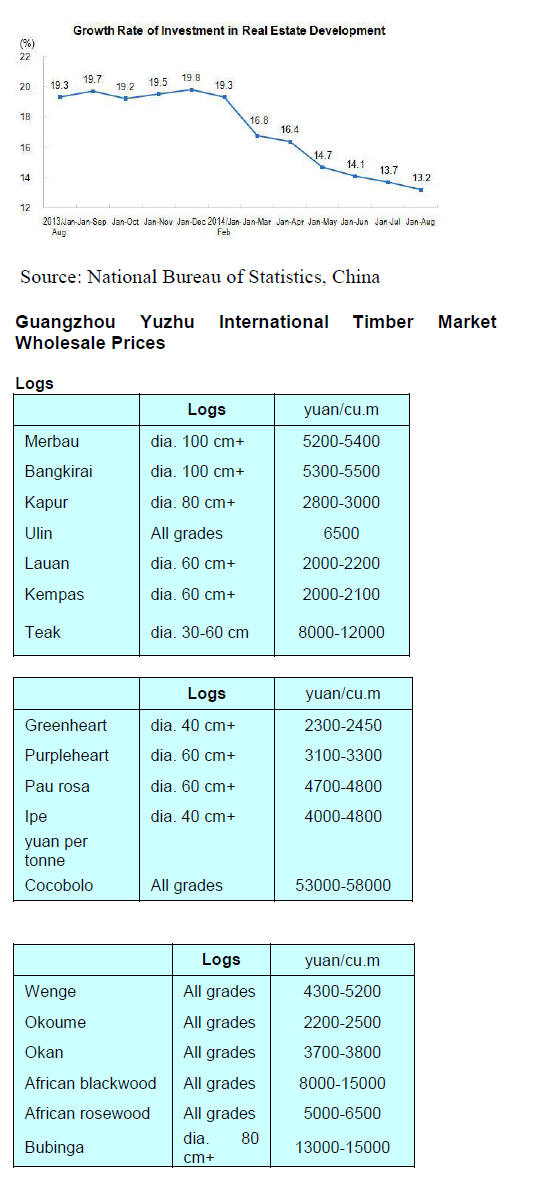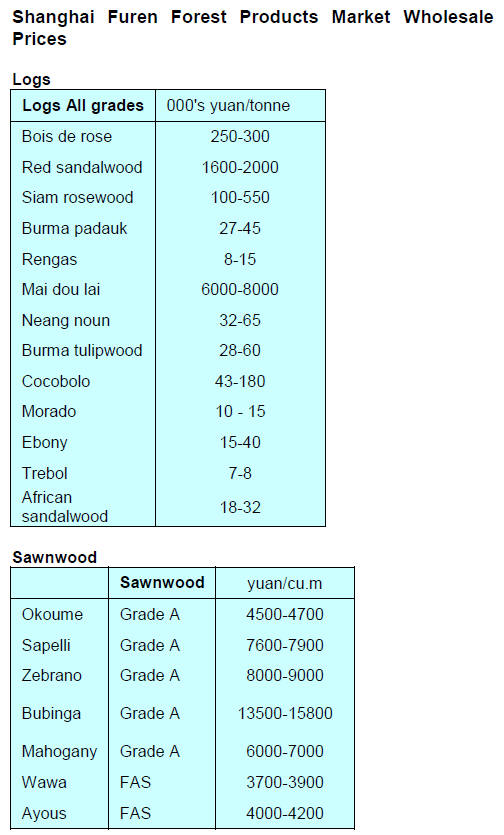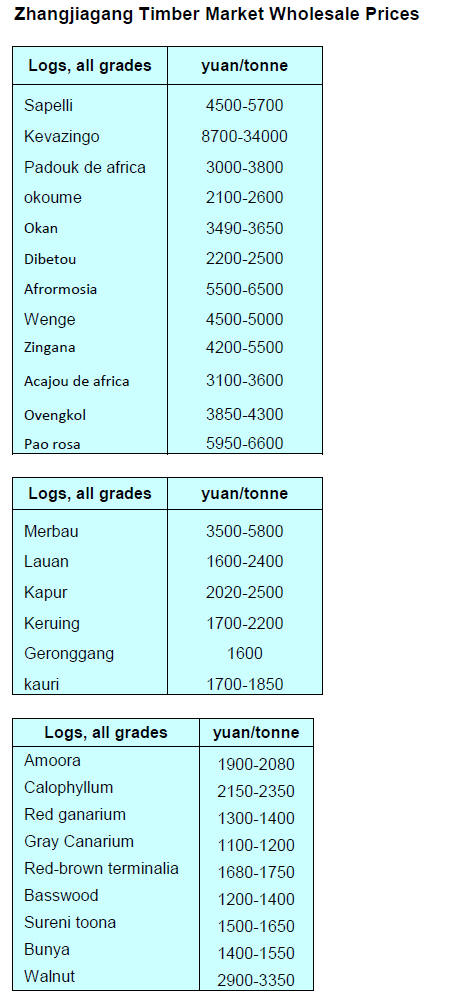US Dollar Exchange Rates of
25th September
2014
China Yuan 6.1272
Report from China
High stocks of imported timber drive down prices
Zhu Guangqian, a consultant for the China National Forest
Product Industry Association has said that current stocks
of imported timber exceed domestic demand and many
timber traders fear they will lose money on recent imports.
Despite the high stocks the level of imports continues to
expand.
Prices for imported logs began to increase in the second
quarter of 2013 and Chinese traders began to increase
imports but as demand cooled stocks rose and from April
this year prices for imported logs began to fall.
For example, from the middle of this year prices for
imported logs from North America fell between RMB60-
70 per cubic metre, prices for Russia timbers were down
RMB30 per cubic metre and the current price for scots
pine from Europe is down RMB60 per cubic metre.
Analysts estimate current stock are around 5 million cubic
metres, up over 52% from the beginning of this year. Most
of this stock is of timber imported in the first quarter of
this year when prices were firm.
For more see:
http://www.chinatimber.org/news/55289.html
Bamboo industry output will top US$48 billion by 2020
China has 7.2 million hectares of bamboo forest,
accounting for one fourth of the global total of which 4.2
million hectares are unmixed bamboo forest and mainly
distributed in 20 provinces of the Yangtze River Basin,
southern China and the southwest region.
Moso bamboo (tortoise-shell bamboo, or mao zhu) is a
temperate species of giant timber bamboo and is widely
distributed China. At present, the annual value of China's
bamboo industry output is US$14.5 billion.
According to the China Bamboo Industry Development
Plan formulated in 2013, the total value of China‟s
bamboo industry output will be US$48 billion by 2020 and
direct employment in the bamboo industry could grow to
10 million.
There are thousands of bamboo products which can be
grouped into the following major categories: bamboo
products for daily use, bamboo arts and crafts, bamboo
panels, bamboo charcoal, paper making, furniture,
packaging, medicine, food and textiles. Bamboo has even
been used to make keyboards and hardware framework.
However, there are some problems in China‟s bamboo
processing industry. Currently most of China‟s bamboo
processing industries are very small scale. The number of
bamboo processing enterprises with annual output value of
RMB10 million account for only 8% of all entreprises.
The quality of bamboo products from many small
enterprises is said to be poor.
Plantation area steams ahead
It has been reported that the area of China‟s plantations, at
6.93 million hectares, has lifted the country into the ranks
of top planters. The area of China‟s forest has been
assessed at 20.8 million hectares, the national forest cover
is 21.63% and the forest stock volume is said to be around
15.1 billion cubic metres.
The average annual growth in forestry output exceeds 20%
and the total value of China‟s forest sector output reached
RMB4.73 trillion in 2013 while the value of international
trade in wood products in 2013 was US$126 billion.
Redwood imports spike in the first half of 2014
According to data from China‟s Customs, timber first half
timber imports rose 21% to 44.39 million cubic metres
while the value of timber imports was up 40% to
US$10.44 billion.
Of the total,‟ redwood‟ imports increased more than 300%
to 1.21 million cubic metres valued at US$1.66 billion, up
more than 500% in value from the same period of 2013.
Around 80% of the total redwood imports were through
Guangdong, Shanghai and Yunnan provinces (84% of the
total) and amounted to 990,000 cubic metres.
China‟s Redwood Committee notes that the surge in
redwood imports reflects the current huge demand for
redwood products in domestic market. The rapid growth of
redwood imports has tied up huge amounts of private
capital and many enterprises are now feeling the financial
strain from investing so heavily in redwood stocks.
MDF exports through Wuzhou City increasing 12 times
The international demand for MDF has been increasing
since the beginning of this year and manufacturers in
Wuzhou City have been successful in international
markets.
According to the statistics from Wuzhou Customs of
Guangxi Zhuang Autonomous Region, the value of MDF
exports through Wuzhou City were RMB31.85 million
accounting for 80% of the provincial export value and a 12
fold increase from the same period in 2013. Of the total,
the value of all MDF exports to Iran amounted to
RMB26.65 million or 84% of the total export value.
Chinese experts have suggested that regional governments
should encourage and guide export enterprises to pay more
attention to quality rather than volume.
Plywood production in Wen¡¯an City
The plywood industry in Wen‟an in Hebei Province has
grown and the annual output accounts for one-seventh of
the national total. The development of Wen'an wood-based
panel industry started in 1986.
Wen‟an County has become the Home of China‟s woodbased
panel industry along with Shandong Linyi, Jiangsu
Pizhou, Zhejiang Jiashan.
Wen‟an County has more than 1500 wood-based panel
processing and trade enterprises and companies are
actively exporting to Japan, S.Korea, USA, Turkey and
Southeast Asian countries.
The local administration in Wen'an county has been
encouraging farmers to plant fast growing trees to support
the growing industrial base. The area of plantations
currently stands at around 28,700 hectares.
All-out effort to prop up housing market
The National Bureau of Statistics latest survey of house
price trends points to a steady decline in most of the major
cities.
In the 70 medium and large-sized cities included in the
survey new home prices declined in 68 cities, remained
unchanged in one and rose in only one. A similar trend
was reported for second hand homes where prices fell in
95% of the total cities surveyed.
The real estate sector in China accounts for over 12% of
GDP and the health of this sector has a huge impact on a
wide range of industries from furniture to concrete
manufacturers such that a depressed housing market is a
drag on the overall economy.
See:
http://www.stats.gov.cn/english/PressRelease/201409/t20140918
_611951.html
In a quick turn-around from trying to cool the housing
market, today efforts are being ploughed into encouraging
buyers with loans being offered even to those wishing to
purchase a second property. The thrust of this
development is being led by regional governments as they
fear the impact on local employment of a housing slump.
See:
http://www.stats.gov.cn/english/PressRelease/201409/t201
40915_609461.html

  

|